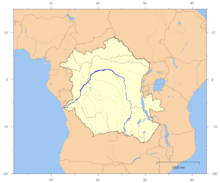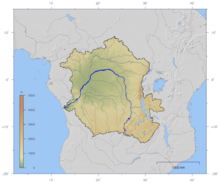Congo River
| Congo | |
|---|---|
| | |
| Mouth | Atlantic Ocean |
| Basin countries | Democratic Republic of the Congo, Central African Republic, Republic of the Congo |
| Length | 4,667 km (2,900 mi) |
| Avg. discharge | 41,800 m³/s (1,476,376 ft³/s) |
| Basin area | 3,680,000 km² (1,420,848 mi²) |
The Congo River (for a time known as the Zaire River) is the largest river in western Central Africa. Its overall length of 2,718 mi.(4,374 km) makes it the second-longest in Africa (after the Nile). The river and its tributaries flow through the second largest rain forest area in the world,[1] second only to the Amazon Rainforest in South America. The river also has the second-largest flow in the world, behind the Amazon, and the second-largest watershed of any river, again trailing the Amazon; its watershed is slightly larger than that of the Mississippi River. Because large sections of the river basin lie above and below the equator, its flow is stable, as there is always at least one river experiencing a rainy season.[1]
The Congo gets its name from the ancient Kingdom of Kongo, which inhabited the lands at the mouth of the river. The Democratic Republic of the Congo and the Republic of the Congo, both countries lying along the river's banks, are named after it. Between 1971 and 1997 the government of then-Zaire called it the Zaire River.
The sources of the Congo are in the highlands and mountains of the Great Rift Valley, as well as Lake Tanganyika and Lake Mweru, which feed the Lualaba River, which then becomes the Congo below Boyoma Falls. The Chambeshi River in Zambia is generally taken as the source of the Congo, in line with the accepted practice worldwide of using the longest tributary, as with the Nile River.
The Congo flows generally west from Kisangani just below the falls, then gradually bends southwest, passing by Mbandaka, joining with the Ubangi River, and running into the Pool Malebo (Stanley Pool). Kinshasa (formerly Léopoldville) and Brazzaville are on opposite sides of the river at the Pool, then the river narrows and falls through a number of cataracts in deep canyons (collectively known as the Livingstone Falls), running by Matadi and Boma, and into the sea at the small town of Muanda.
History of exploration
The mouth of the Congo was visited in 1482 by the Portuguese explorer Diogo Cão, and in 1816 by a British expedition that went up as far as Isangila. Henry Morton Stanley was the first European to navigate along the river's length and report that the Lualaba was not a source of the Nile, as had been suggested.
Economic importance
Nearly the entire Congo is readily navigable, and with railways now bypassing the three major falls, much of the trade of central Africa passes along it, including copper, palm oil (as kernels), sugar, coffee, and cotton. The river is also potentially valuable for hydroelectric power, and the Inga Dams below Pool Malebo are first to exploit the river.
Trade along the river has historically been a carrier of culture as well as commerce.
In February 2005, South Africa's state-owned power company, Eskom, announced a proposal to increase the capacity of the Inga dramatically through improvements and the construction of a new hydroelectric dam. The project would bring the maximum output of the facility to 40 GW, twice that of China's Three Gorges Dam. [2]
Tributaries
Sorted in order from the mouth heading upstream.
- Inkisi
- Nzadi
- Nsele (south side of Pool Malebo)
- Bombo
- Kasai (between Fimi and Congo, known as Kwa)
- Fimi
- Kwango
- Sankuru
- Likouala
- Sangha
- Ubangi
- Giri
- Uele
- Mbomou
Geological history
In the Mesozoic before continental drift opened the South Atlantic Ocean, the Congo was the upper part of a river roughly 7,500 miles (12,000 km) long that flowed west across the parts of Gondwanaland that are now Africa and South America.
ReferencesISBN links support NWE through referral fees
- Helen Winternitz, East Along the Equator: A Journey up the Congo and into Zaire, 1987. Atlantic Monthly Press, New York, NY.
- James L. Newman, The Peopling of Africa: A Geographical Interpretation, 1995. Yale University Press, New Haven, CT. ISBN 0300060033
External links
- Bibliography on Water Resources and International Law See Congo (or Zaïre) River. Peace Palace Library
- Information and a map of the Congo's watershed
- Map of the Congo River basin at Water Resources eAtlas
Credits
New World Encyclopedia writers and editors rewrote and completed the Wikipedia article in accordance with New World Encyclopedia standards. This article abides by terms of the Creative Commons CC-by-sa 3.0 License (CC-by-sa), which may be used and disseminated with proper attribution. Credit is due under the terms of this license that can reference both the New World Encyclopedia contributors and the selfless volunteer contributors of the Wikimedia Foundation. To cite this article click here for a list of acceptable citing formats.The history of earlier contributions by wikipedians is accessible to researchers here:
The history of this article since it was imported to New World Encyclopedia:
Note: Some restrictions may apply to use of individual images which are separately licensed.
- ↑ The Rainforest Foundation (June 21, 2006). A fresh step toward the first indigenous rights law in Republic of Congo.
- ↑ [2]

